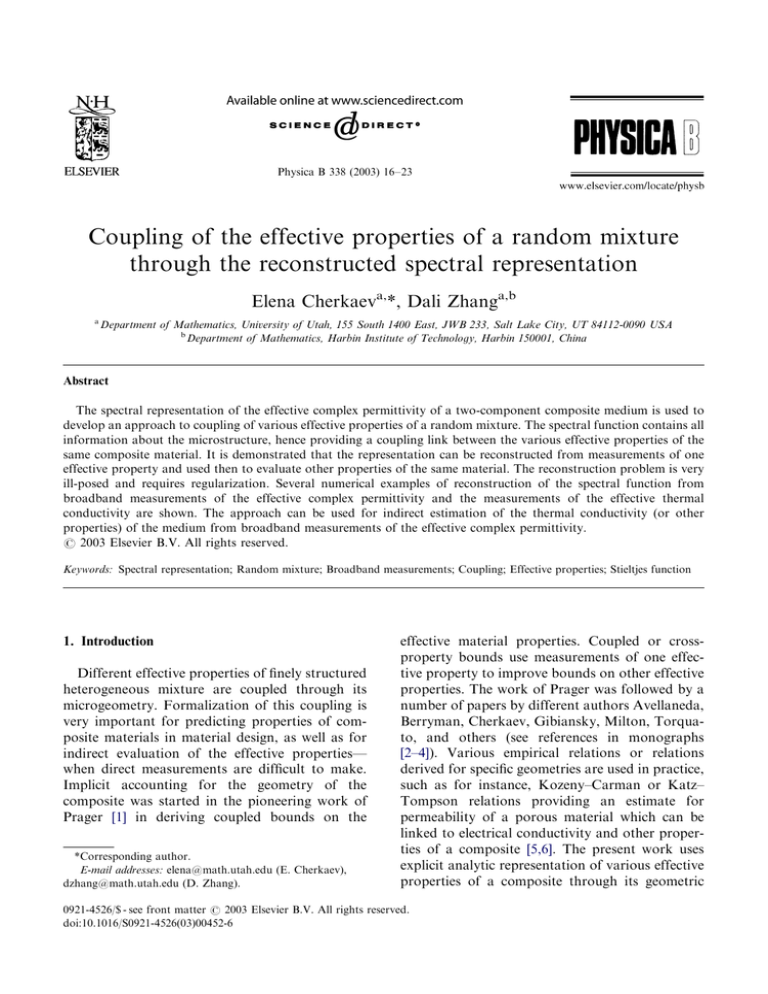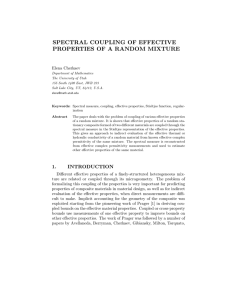Coupling of the effective properties of a random mixture
advertisement

ARTICLE IN PRESS Physica B 338 (2003) 16–23 Coupling of the effective properties of a random mixture through the reconstructed spectral representation Elena Cherkaeva,*, Dali Zhanga,b a Department of Mathematics, University of Utah, 155 South 1400 East, JWB 233, Salt Lake City, UT 84112-0090 USA b Department of Mathematics, Harbin Institute of Technology, Harbin 150001, China Abstract The spectral representation of the effective complex permittivity of a two-component composite medium is used to develop an approach to coupling of various effective properties of a random mixture. The spectral function contains all information about the microstructure, hence providing a coupling link between the various effective properties of the same composite material. It is demonstrated that the representation can be reconstructed from measurements of one effective property and used then to evaluate other properties of the same material. The reconstruction problem is very ill-posed and requires regularization. Several numerical examples of reconstruction of the spectral function from broadband measurements of the effective complex permittivity and the measurements of the effective thermal conductivity are shown. The approach can be used for indirect estimation of the thermal conductivity (or other properties) of the medium from broadband measurements of the effective complex permittivity. r 2003 Elsevier B.V. All rights reserved. Keywords: Spectral representation; Random mixture; Broadband measurements; Coupling; Effective properties; Stieltjes function 1. Introduction Different effective properties of finely structured heterogeneous mixture are coupled through its microgeometry. Formalization of this coupling is very important for predicting properties of composite materials in material design, as well as for indirect evaluation of the effective properties— when direct measurements are difficult to make. Implicit accounting for the geometry of the composite was started in the pioneering work of Prager [1] in deriving coupled bounds on the *Corresponding author. E-mail addresses: elena@math.utah.edu (E. Cherkaev), dzhang@math.utah.edu (D. Zhang). effective material properties. Coupled or crossproperty bounds use measurements of one effective property to improve bounds on other effective properties. The work of Prager was followed by a number of papers by different authors Avellaneda, Berryman, Cherkaev, Gibiansky, Milton, Torquato, and others (see references in monographs [2–4]). Various empirical relations or relations derived for specific geometries are used in practice, such as for instance, Kozeny–Carman or Katz– Tompson relations providing an estimate for permeability of a porous material which can be linked to electrical conductivity and other properties of a composite [5,6]. The present work uses explicit analytic representation of various effective properties of a composite through its geometric 0921-4526/$ - see front matter r 2003 Elsevier B.V. All rights reserved. doi:10.1016/S0921-4526(03)00452-6 ARTICLE IN PRESS E. Cherkaev, D. Zhang / Physica B 338 (2003) 16–23 structural function associated with the spectral measure m in the Stieltjes analytic integral representation of the effective complex permittivity e : This analytic integral representation of the effective permittivity e of a mixture of two materials with permittivity e1 and e2 was developed by Bergman, Milton, and Golden and Papanicolaou [7–11] in the course of computing bounds for the effective permittivity of an arbitrary two component mixture. The integral representation gives a function F ðsÞ as an analytic function outside the ½0; 1-interval in the complex s-plane: Z 1 e dmðzÞ 1 ; s¼ F ðsÞ ¼ 1 ¼ : ð1Þ e2 s z 1 e1 =e2 0 Here the positive measure m is the spectral measure of a self-adjoint operator Gw; with w being the characteristic function of the domain occupied by one material, and G ¼ rðDÞ1 ðrÞ: The spectral function m was used to derive microstructural information about the composite [12–14], to bound the effective permittivity [10,8,15], to appraise the accuracy of the permittivity measurements [16], and to model the effective complex conductivity of geological mixtures [17,18] or of random resistor networks [19], it is calculated from reflectivity measurements at different temperatures in Ref. [20]. The present paper discusses coupling of different properties of a stationary random mixture through the spectral function m: It is demonstrated in Ref. [6] that different properties of a random mixture admit a representation similar to Eq. (1) with the same function m; and that the effective response of the random medium for a range of different parameters of the applied field determines the function m: Hence, when computed from measurements of one effective property (say, from measurements of e ), the function m can be used to evaluate the effective response of the same medium for other applied fields as well. From the computational point of view, the problem of reconstruction of the spectral measure m is extremely ill-posed: It is equivalent to the inverse potential problem and requires regularization. We show computational results of recovering the spectral function m from numerically simulated effective measurements of the complex permittivity 17 of a second-rank composite using regularized algorithms developed in Refs. [6,22]. As an example, the thermal conductivity of St. Peters sandstone is estimated using the reconstructed function m: We also show an example of calculation of the function m from experimental measurements of the thermal conductivity of Berea and Tensleep sandstones [22]. Computed values of the thermal conductivity are in good agreement with measured values in Ref. [24]. 2. Motivation The knowledge of the thermal conductivity of a material is important in examining any phenomena concerning conductive heat flow. Some geophysical applications include oil reservoir simulation, high level nuclear waste containment modeling, and geothermal reservoir production simulation. Determination of the in situ distribution of thermal conductivity over a scale of meters to tens of meters using heat sources is not done typically because of the time required to diffuse a temperature field over these distances and because of the energy required for placing and maintaining calibrated heat sources. The present paper suggests an indirect approach to evaluation of the thermal conductivity of a composite medium or geological formation based on coupling of various effective properties of a composite material. Geophysical materials are often two-scale media: Spatial variation of the complex permittivity on the large scale can be reconstructed from the measurements of the electromagnetic field on the surface and in boreholes. On a small scale, the medium is a random mixture of two components. For a two-component material such as a porous medium filled with fluid, the inverse homogenization theory suggests that the complex permittivity of the mixture, known over a broad frequency band, determines the thermal conductivity of the same composite. A coupling link between different properties of a porous medium is based on the spectral representation of the effective properties of the two-component composite medium. This indirect approach to evaluation of effective properties of a medium can be of importance in ARTICLE IN PRESS E. Cherkaev, D. Zhang / Physica B 338 (2003) 16–23 18 applications where direct measurements are restricted or unavailable. 3. Coupled spectral representation of effective properties of a two-component mixture We consider a stationary random mixture of two materials with the complex permittivity ei and thermal conductivity ki ; i ¼ 1; 2: Theorem. Assuming that the known properties ei ¼ ei ðpÞ; i ¼ 1 or 2, of materials in a stationary random mixture depend on a parameter p, measurements of the effective complex permittivity e ðpÞ in an interval pAðp1 ; p2 Þ uniquely determine the effective thermal conductivity k of the mixture for given values of the components ki ; i ¼ 1; 2: The key observation is that the effective properties e and k are coupled through the function m in their integral representation: Z 1 dmðzÞ 1 ; s¼ e ðsÞ ¼ e2 e2 ; ð2Þ s z 1 e1 =e2 0 k ðs0 Þ ¼ k2 k2 Z 0 1 dmðzÞ ; s0 z s0 ¼ 1 : 1 k1 =k2 ð3Þ If the function m is known from the measurements of e ; evaluation of the effective thermal conductivity k reduces to a simple calculation. Indeed, let the function F ðsÞ (1) corresponding to e ; be represented as X an : ð4Þ F ðsÞ ¼ s zn n The corresponding spectral function m has the form: X dmðzÞ ¼ an dðz zn Þ dz: ð5Þ n Then the effective thermal conductivity of the mixture with the thermal conductivity of the components k1 and k2 can be calculated as ! X an k ¼ k2 1 ð6Þ s 0 zn n with s0 defined in Eq. (3). It was shown in Ref. [6] that the measure m can be uniquely reconstructed from the measurements of e if the data are available on an arc in the complex plane. This is the case when the complex permittivity of one of the materials in the mixture depends on the frequency, and the measurements of the e are available in a continuous interval of frequency of the applied field. Another example could be provided by a porous medium saturated with different fluids. In both cases, the materials in the mixture change their properties, but the microgeometry does not change. Transformed to the s-plane, the data points will correspond to the same function F ðsÞ with different values s belonging to some arc, sAC: The idea is to consider (1) as an integral equation and try to solve it and to find the corresponding function m: 4. Ill-posedness of the problem and regularization The problem of reconstruction of the spectral measure m can be reduced to an inverse potential problem. The function F ðsÞ admits a representation as a logarithmic potential of the measure m Z @ ln js zj dmðzÞ; F ðsÞ ¼ @s @=@s ¼ ð@=@x i@=@yÞ: ð7Þ The reconstruction problem for the logarithmic potential is extremely ill-posed and requires regularization to develop a stable numerical algorithm. Let A be an operator in Eq. (7) mapping the set of measures M½0; 1 on the unit interval onto the set of complex potentials defined on a curve C : zðsÞ ¼ 0: AmðsÞ ¼ f ðsÞ þ igðsÞ Z @ 1 ¼ ln js zj dmðzÞ; @s 0 sAC: ð8Þ To construct the solution we formulate the minimization problem: jjAm F jj- min ; mAM ð9Þ where jj jj is the L2 ðCÞ-norm, F is the function of the measured data, F ðsÞ ¼ 1 e ðsÞ=e2 ; sAC: The solution of the problem does not continuously ARTICLE IN PRESS E. Cherkaev, D. Zhang / Physica B 338 (2003) 16–23 depend on the data: Unboundness of the operator A1 leads to arbitrarily large variations in the solution, and the problem requires a regularization technique. A regularization algorithm developed in Ref. [6] is based on constrained minimization: It introduces a stabilization functional JðmÞ which constrains the set of minimizers. As a result, the solution depends continuously on the input data. Instead of minimizing (9) over all functions in M; minimization is performed over a convex subset of functions which satisfy JðmÞpb; for some scalar b > 0: We used a quadratic stabilization functional and a total variation functional. Since the solution of the constrained minimization problem min m: JðmÞpb jjAm F d jj ð10Þ occurs on the boundary of the constrained region where JðmÞ ¼ b; we can reformulate (10) in terms of an unconstrained minimization problem using the Lagrange multipliers method. This approach leads to an equivalent formulation that uses the Tikhonov regularization functional Ja ðm; F d Þ; so that problem (10) is equivalent to solving the unconstrained minimization problem with a regularization parameter a (see Ref. [23]): Ja ðm; F d Þ ¼ jjAm F d jj2 þ aJðmÞ; Ja ðm; F d Þ- min : mAM ð11Þ The advantage of using a quadratic stabilization functional JðmÞ ¼ jjLmjj2 ; is the linearity of the corresponding Euler equation resulting in efficiency of the numerical schemes: m ¼ ðA A þ aL LÞ1 A F d : ð12Þ a However, the reconstructed solution necessarily possesses a certain smoothness. The alternative regularization based on the non-negativity constraint [21], does not impose smoothness on the solution, this permits recovering sharp features of the solution. In this approach the non-negativity of the function m is used explicitly in the algorithm, which becomes a constrained minimization algorithm: jjAm F jj- minþ ; mAM ð13Þ 19 where Mþ is a subset of non-negative functions on unit interval. 5. Numerical examples 5.1. Frequency dependent complex permittivity of the medium As a first test example we consider a very simple microgeometry formed by ellipsoids of volume v with a dielectric constant e1 embedded in a much larger homogeneous host with a dielectric constant e2 : e1 e2 : ð14Þ e ¼ e2 þ v=V e2 e2 þ nðe1 e2 Þ Here V is the total volume, n is depolarization factor, n ¼ 13 for spheres. It can be seen that e diverges when e1 ¼ ð1 nÞe2 =n; after transformation to the s-plane this gives a pole at z0 ¼ 13: We assume that the complex permittivity of water is given by the Debye relaxation function: es eN : ð15Þ ewater ¼ eN þ 1 þ iot Here es is the static dielectric constant (the value at zero frequency), eN is the value at high frequency, o ¼ 2pf is the angular frequency, with f being the frequency of the field, and t is the relaxation time. In the present numerical example these parameters have the values: es ¼ 80; eN ¼ 4:9; t ¼ 7:20 ps: The second component in the mixture is assumed to have complex permittivity of sandstone, which does not vary with frequency. Numerically simulated values of the imaginary part of the effective complex permittivity in a range of frequency were used to recover the function m: Results of reconstruction of the spectral function m for this example using Tikhonov regularization are shown in Fig. 1. The left figure shows solutions computed with different parameters a: Solutions calculated with too small values of regularization parameter a are shown on the right. These shown in the right figure results indicate that the problem cannot be solved without regularization. The true delta function solution at z0 ¼ 13; can be reconstructed almost exactly with a ARTICLE IN PRESS E. Cherkaev, D. Zhang / Physica B 338 (2003) 16–23 20 0.03 20 15 0.02 10 5 0 0.01 -5 -10 0.00 -15 -20 -0.01 0.1 0.2 0.3 0.4 0.5 0.6 0.7 0.8 0.9 1 -25 0 0.1 0.2 0.3 0.4 0.5 0.6 0.7 0.8 0.9 1 Fig. 1. Reconstruction of the spectral function using Tikhonov regularization. The true solution is a delta function at z0 ¼ 13: Smooth functions on the left figure are computed with different parameters a: Solutions calculated with too small values of regularization parameter a are shown on the right. non-negativity constraint used for regularizing this problem in Ref. [21]. 5.2. Reconstruction of the spectral function for the second rank laminate s1 ; s2 are the following: pffiffiffiffiffiffiffiffiffiffiffiffiffiffiffiffiffiffiffiffiffiffiffiffiffiffiffi s1 ¼ 12ð1 þ 1 4p2 m1 m2 Þ; pffiffiffiffiffiffiffiffiffiffiffiffiffiffiffiffiffiffiffiffiffiffiffiffiffiffiffi s2 ¼ 12ð1 1 4p2 m1 m2 Þ ð18Þ and A1 ; A2 are given as The effective complex permittivity of the second rank laminate structure shown in Fig. 2 can be calculated analytically. The corresponding func% tion FðsÞ has components Fx ðsÞ and Fy ðsÞ in the directions x and y: F% ¼ Fx 0 0 Fy ! e ¼I ; e2 e ¼ ex 0 0 ey ! ; ð16Þ where the functions Fx ðsÞ and Fy ðsÞ in the s-plane are: mx 0 0 my ! ¼ 0:12dðs 0:09Þ þ 0:076dðs 0:91Þ 0 A1 A2 Fx ðsÞ ¼ m1 þ ; s s1 s s2 p2 p1 þ : Fy ðsÞ ¼ m1 s s m2 A1 ¼ 1 p2 m2 s1 ; s2 s1 A2 ¼ 1 p2 m 2 s 2 : s1 s2 ð19Þ Numerically simulated values of ex and ey were used to calculate the spectral measures mx and my : The results of computation using the inversion method [21] are shown in the right Fig. 2. The parameters of the laminate were taken as m1 ¼ 0:2; m2 ¼ 0:8 for the first rank layers, and p1 ¼ 0:5; p2 ¼ 0:5 for the second rank layers. The true spectral function found analytically is ! 0 : 0:1dðsÞ þ 0:1dðs 0:8Þ ð20Þ Reconstructed solution shown on the right in Fig. 2, very well identifies the support of the spectral function as well as its amplitude. ð17Þ Here m1 and m2 are volume fractions of materials in the first rank layers, while p1 and p2 are volume fractions in the second rank layers. Parameters 5.3. Reconstruction of the spectral function from experimental data for thermal conductivity We applied the algorithm to reconstruction of the function m from experimental thermal ARTICLE IN PRESS E. Cherkaev, D. Zhang / Physica B 338 (2003) 16–23 21 Spectral function of 2−nd rank laminate 0.1 µy 0.09 0.08 0.07 µx µx µy 0.06 0.05 0.04 0.03 ε *y 0.02 0.01 0 ε x* 0 0.2 0.4 0.6 0.8 1.0 Fig. 2. The left figure shows geometry of the 2nd rank laminate. Figure on the right shows two components mx and my of the spectral function of 2nd rank laminate reconstructed from the simulated effective comlex permittivity e : conductivity data measured in Ref. [22]. In this work the samples of various sandstone materials were saturated with different fluids with known thermal conductivity ks : The sandstone is a random mixture of sandgrains (about 90% quartz) and saturating fluid (gas). The thermal conductivity of the quartz was assumed to be 20 mcal=cm s C: We analyze two sets of measurements of the effective thermal conductivity k for Berea sandstone and for Tensleep sandstone. The data sets were very small, and one data point in both sets was far away from the rest of the measurements. We did not consider this outermost point since we did not have enough information to try to fit it in. The reconstructed spectral functions corresponding to these two data sets are shown in Fig. 3. Fig. 4 shows the original data points together with the calculated values for the effective thermal conductivity, as well as these values transformed to the s-plane. The constructed function can be used to evaluate other properties of the same sandstone by exploiting Eq. (6). Of course, the accuracy of approximating the effective behavior of composite depends on the distance of the point s0 to the set of measured data points used in computation. This resolution issue will be addressed separately. e ðoÞ ¼ egrain 1 0.12 Spectral function µ 0.1 0.08 1 0.06 0.04 0.02 2 1−Berea sandstone 2−Tensleep sandstone 0 0 0.2 0.4 0.6 0.8 1.0 Fig. 3. The spectral function reconstructed from experimental data on the thermal conductivity of Berea and Tensleep sandstones. 5.4. Comparison with experimental data For appraisal of the suggested indirect method of computation of the effective properties of the composite from a known effective complex permittivity, the approach was applied to the data for St. Peters sandstone, which is composed of sandgrains and has 11% porosity. Assuming the porous space is filled with water, with known dependence of ewater on frequency, given by Eq. (15), measurements of the effective e ðoÞ were simulated using the Maxwell–Garnett formula for a two phase composite material. dpwater ðegrain ewater ðoÞÞ : egrain ðd 1Þ þ ewater ðoÞ þ pwater ðegrain ewater ðoÞÞ ð21Þ ARTICLE IN PRESS E. Cherkaev, D. Zhang / Physica B 338 (2003) 16–23 22 0.9 * Thermal conductivity k for Berea and Tensleep sandstones Calculated approximation to F(s) 0.8 12 0.7 10 0.6 F(s) Effective conductivity k * 14 8 0.5 6 0.4 0.3 4 0 0.2 0.4 0.6 0.8 1 Saturant conductivity k f 1.2 1.4 1.6 0.2 Berea sandstone: measured Berea sandstone: computed Tensleep sandstone: measured Tensleep sandstone: computed 1 1.02 1.04 s 1.06 1.08 Fig. 4. The left figure shows the original measured data points together with the calculated values for the effective thermal conductivity k : The right figure shows the corresponding values F ðsÞ on the real axis in the s-plane which were used in calculations. Table 1 Thermal conductivity of St. Peters sandstone Measured Computed Wet sandstone Dry sandstone 6.36 6.63 3.56 3.55 The approach might provide an alternative indirect method of evaluation of the material properties of the medium using remote electromagnetic measurements. Acknowledgements Here d is the dimension, d ¼ 3; and pwater ¼ 0:11 is the fraction of water in the mixture. These simulated data of e ðoÞ were used to compute the spectral function m; which was used then to calculate the thermal conductivity of the rock. Computed and measured data for wet (sandgrains and 11% of water) and dry (sandgrains and 11% of air) sandstone are summarized in Table 1. Experimental data taken for comparison from Ref. [24] are shown as well in the table. Values of the thermal conductivity computed using the developed algorithm are in good agreement with the measured data. This comparison suggests that the method can be used for indirect evaluation of various effective properties of a random mixture computing them from measured complex permittivity or other properties of the composite. 6. Conclusion Coupling of various effective properties of the mixture permits the use of the permittivity data to evaluate the thermal conductivity of the material. The authors are grateful to Alan C. Tripp for providing the thermal conductivity data and many helpful comments. This work was partially supported by DOE/OBES grant DE-FG0393ER14313, ONR grant N0000149310141, and Schlumberger-Doll Research. References [1] S. Prager, J. Chem. Phys. 50 (10) (1969) 4305. [2] A. Cherkaev, Variational Methods for Structural Optimization, Springer, New York, 2000. [3] G.W. Milton, Theory of Composites, Cambridge Press, Cambridge, 2002. [4] S. Torquato, Random Heterogeneous Materials. Microstructure and Macroscopic Properties, Springer, New York, 2002. [5] M. Avellaneda, S. Torquato, Phys. Fluids A 3 (11) (1991) 2529. [6] E. Cherkaev, In verse Problems 17 (2001) 1203. [7] D.J. Bergman, Phys. Rep. C 43 (1978) 377. [8] D.J. Bergman, Ann. Phys. 138 (1982) 78. [9] G.W. Milton, Appl. Phys. Lett. 37 (3) (1980) 300. [10] G.W. Milton, J. Appl. Phys. 52 (8) (1981) 5286. ARTICLE IN PRESS E. Cherkaev, D. Zhang / Physica B 338 (2003) 16–23 [11] K. Golden, G. Papanicolaou, Commun. Math. Phys. 90 (1983) 473. [12] R.C. McPhedran, D.R. McKenzie, G.W. Milton, Appl. Phys. A 29 (1982) 19. [13] R.C. McPhedran, G.W. Milton, Mater. Res. Soc. Symp. Proc. 195 (1990) 257. [14] E. Cherkaeva, K.M. Golden, Waves Random Media 8 (1998) 437. [15] D.J. Bergman, SIAM, J. Appl. Math. 53 (4) (1993) 915. [16] D. Eyre, G.W. Milton, J.V. Mantese, Phys. Rev. Lett. 79 (1997) 3062. [17] E. Cherkaeva, A.C. Tripp, Ninth Conference of the European Consortium for Mathematics in Industry, ECMI 96, Denmark, 1996, pp. 304. 23 [18] A.C. Tripp, E. Cherkaeva, J. Hulen, Geophys. Prospecting 46 (6) (1998) 589. [19] A.R. Day, M.F. Thorpe, J. Phys.: Condens. Matter 8 (1996) 4389. [20] A.R. Day, M.F. Thorpe, A.R. Grant, A.J. Sievers, Physica B 279 (2000) 17. [21] E. Cherkaev, P.C. Hansen, A. Berglund, Regularization using non-negativity constraints, to be published. [22] W. Woodside, J.H. Messmer, J. Appl. Phys. 43 (9) (1961) 1699. [23] A.N. Tikhonov, V.Y. Arsenin, Solutions of Ill-posed Problems, Wiley, New York, 1977. [24] J.R. Hearst, P.H. Nelson, Well Logging for Physical Properties, McGraw-Hill, New York, 1985.





